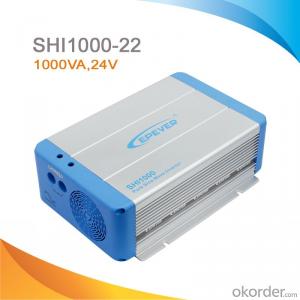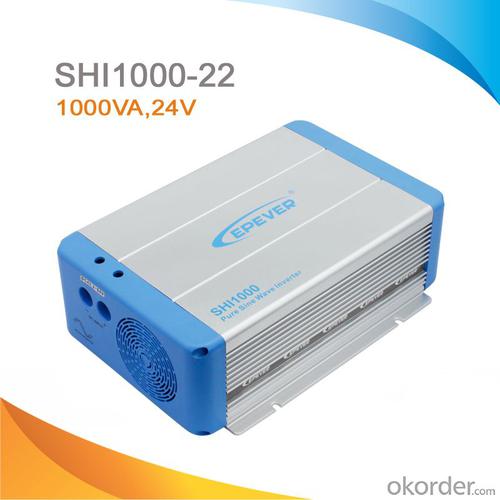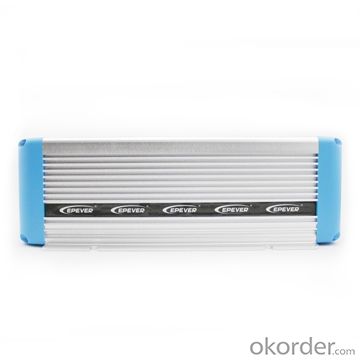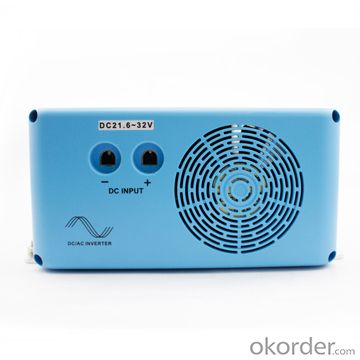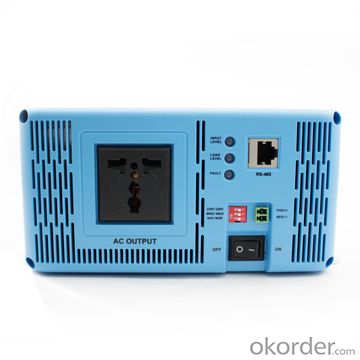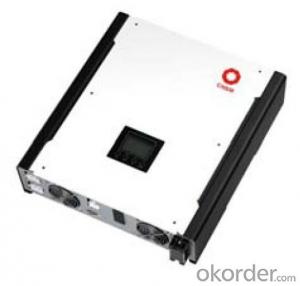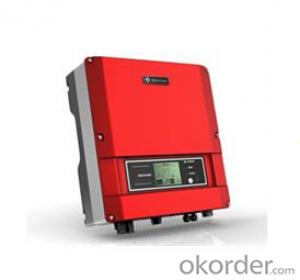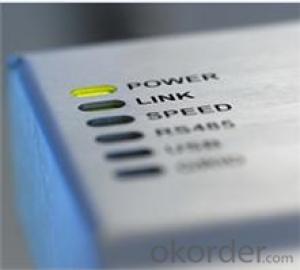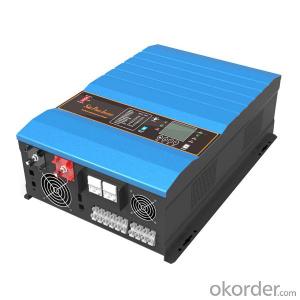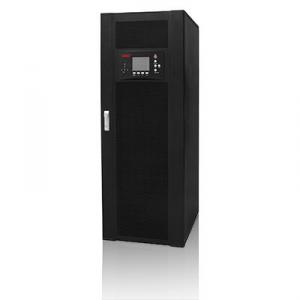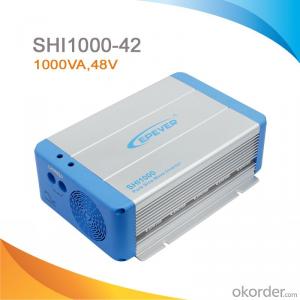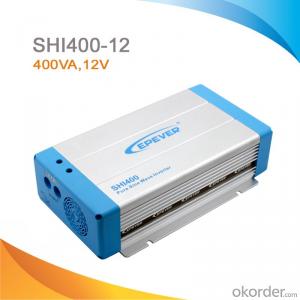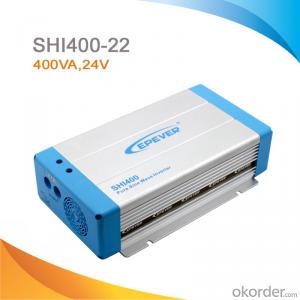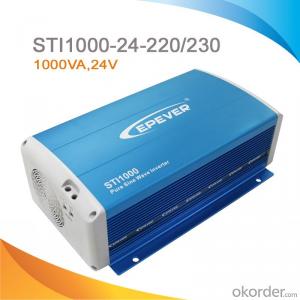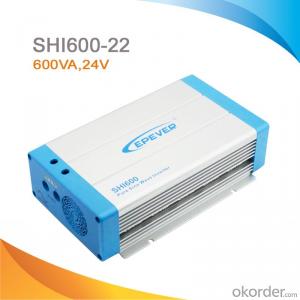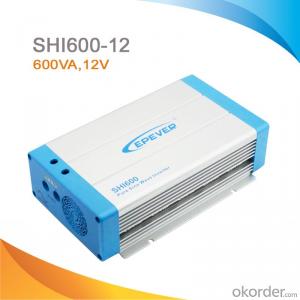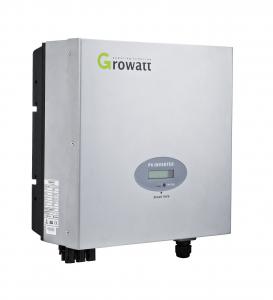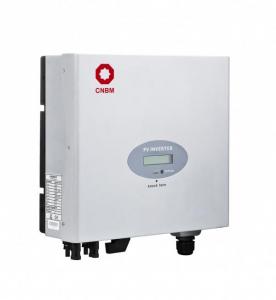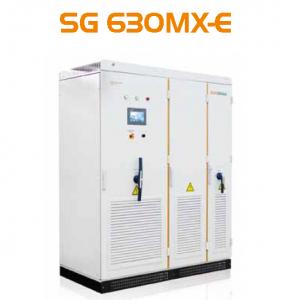Solar Inverter Set SHI 1000W High-Frequency Pure Sine Wave Inverter DC 24V to AC 220V/230V, SHI1000-22
- Loading Port:
- China Main Port
- Payment Terms:
- TT or LC
- Min Order Qty:
- -
- Supply Capability:
- -
OKorder Service Pledge
OKorder Financial Service
You Might Also Like
Description
SHI series is a pure sine wave inverter which can convert 12/24/48Vdc to 220/230Vac 50/60Hz based on full digital and intelligent design. It features high reliability, high efficiency, concise outline, small volume, easy installation and operation. The inverter can be applied in many fields, such as household appliances, electric tools and industrial devices etc, especially for solar photovoltaic power system.
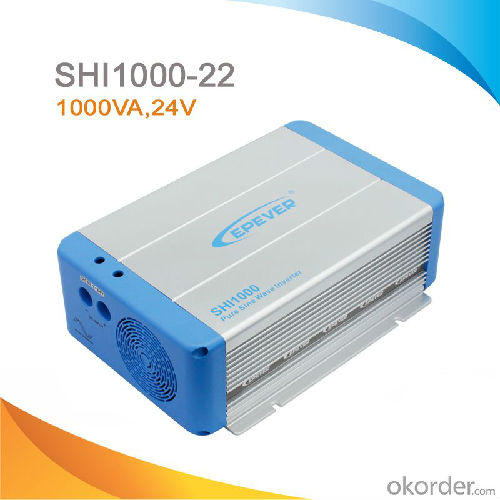
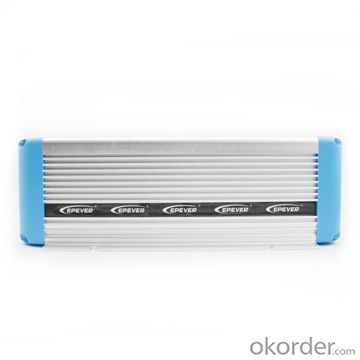
Features:
·Wide DC input voltage range
·The output voltage and frequency can be switched
·Low output harmonic distortion(THD≤3%)
·LED indicators for input voltage range, load power range, normal output & failure state
·Optional energy saving mode
·Wide working temperature range (industrial level)
·Continuous operation at full power
Protections:
·Output short circuit protection
·Overload protection
·Input low voltage protection
·Input over voltage protection
·Overheating protection
·Inverter abnormal protection
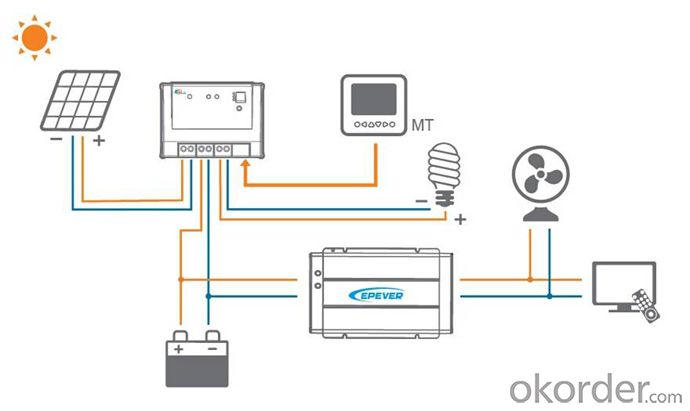
Specification:
Types | SHI1000-22 | SHI1000-42 |
Nominal Battery Voltage | 24V | 48V |
Input Voltage Range | 21.6~32Vdc | 43.2~64Vdc |
No Load Current | ≤0.45A | ≤0.35A |
Output Wave | Pure Sine Wave | |
Output Voltage | 220Vac±3% / 230Vac±10% | |
Continuous Power | 1000W | |
Power 10 sec | 1500W | |
Power 1.5 sec | 2000W | |
Surge Power | 2250W | |
Frequency | 50/60Hz±0.2% | |
Distortion THD | ≤ 3% (resistive load) | |
Efficiency at Rated Power | ≥93% | ≥93.5% |
Max. Efficiency | ≥94% | ≥94% |
Terminal | 25mm2 | |
Dimensions | 295×208×98mm | |
Installation | 150×200mm | |
Hole Size | Φ6mm | |
Net Weight | 3.3kg | |
Working Temperature | -20℃~ +50℃ | |
Storage Temperature | -35℃~ +70℃ | |
Humidity | < 95% (N.C.) | |
Altitude | < 5000m(Derating to operate according to IEC62040 at a height exceeding 1000m) | |
Insulation Resistance | Between DC input terminals and metal case: ≥550MΩ; Between AC output terminals and metal case: ≥550MΩ. | |
Dielectric Strength | Between DC input terminals and metal case: Test voltage AC1500V, 1 minute Between AC output terminals and metal case: Test voltage AC1500V, 1 minute | |
FAQ
Q1:Can we visit your factory?
A1:Sure,welcome at any time,seeing is believing.
Q2:Which payment terms can you accept?
A2:T/T,L/C,Moneygram,Paypal are available for us.
- Q: Can a solar inverter be used with a solar-powered water pumping system?
- Yes, a solar inverter can be used with a solar-powered water pumping system.
- Q: What is the role of a galvanic isolation transformer in a solar inverter?
- The role of a galvanic isolation transformer in a solar inverter is to provide electrical isolation between the input (solar panels) and the output (power grid). This isolation helps in preventing any electrical noise, surges, or ground loops from affecting the solar inverter or the power grid, ensuring safe and reliable operation. Additionally, the galvanic isolation transformer helps in maintaining the required level of insulation and protection, complying with safety standards and regulations.
- Q: How do you choose the right size solar inverter for your system?
- To choose the right size solar inverter for your system, you need to consider the total power output of your solar panels and the maximum power rating of the inverter. It is important to match the inverter's capacity with the maximum power output of your solar panels to ensure optimal performance and efficiency. Additionally, factors such as the type of system (off-grid or grid-tied) and future expansion plans should also be taken into account when determining the appropriate size of the solar inverter for your system.
- Q: How does a solar inverter handle variations in solar irradiation?
- A solar inverter handles variations in solar irradiation by continuously monitoring the incoming solar energy and adjusting its output accordingly. It uses maximum power point tracking (MPPT) technology to ensure that it extracts the maximum power available from the solar panels under different irradiation levels. This allows the inverter to regulate the voltage and current output to match the varying solar conditions, ensuring optimal efficiency and power conversion.
- Q: Can a solar inverter convert DC power to AC power?
- Yes, a solar inverter can convert DC power generated by solar panels into AC power that is suitable for use in homes and businesses.
- Q: How do you monitor the performance of a solar inverter?
- To monitor the performance of a solar inverter, several methods can be employed. Firstly, real-time monitoring systems can be installed that collect data on various parameters such as power output, voltage, current, and temperature. These systems often include data loggers or communication modules that transmit the information to a central monitoring station or cloud-based platform. Additionally, regular inspections and maintenance checks can be conducted to visually inspect the inverter for any signs of damage, loose connections, or overheating. Monitoring the inverter's efficiency over time, comparing the actual power output with the expected output based on solar irradiance and temperature, can also provide insights into its performance. Furthermore, some solar inverters come with built-in monitoring capabilities, allowing users to access performance data through a web-based interface or mobile app. This provides real-time and historical data, including energy production, system faults, and alerts, enabling users to identify and address any issues promptly. Overall, a combination of real-time monitoring systems, regular inspections, and utilizing inverter-specific monitoring features can effectively monitor the performance of a solar inverter.
- Q: What is the role of a grid monitoring feature in a solar inverter?
- The role of a grid monitoring feature in a solar inverter is to constantly monitor the electrical grid for voltage, frequency, and other parameters. This feature ensures that the solar inverter is synchronized with the grid and operates within the specified limits. It helps in maintaining a stable and reliable connection between the solar system and the grid, preventing any damage to the inverter or the grid. Additionally, grid monitoring also enables the solar inverter to detect any faults or abnormalities in the grid and take appropriate measures to protect the system and ensure safe operation.
- Q: How do you calculate the total power capacity for a solar inverter?
- To calculate the total power capacity for a solar inverter, you need to consider two main factors: the maximum power output of the solar panels and the efficiency of the inverter. First, determine the maximum power output of the solar panels in watts. Then, divide this value by the efficiency of the inverter, usually given as a percentage. The resulting value will give you the total power capacity of the solar inverter in watts.
- Q: How does the quality of the AC waveform affect the performance of a solar inverter?
- The quality of the AC waveform directly impacts the performance of a solar inverter. A poor quality waveform can introduce harmonics and distortions, leading to reduced efficiency, increased heat generation, and decreased overall performance of the inverter. It can also cause issues with the functioning of other electrical equipment connected to the inverter. Therefore, ensuring a high-quality and clean AC waveform is crucial for optimal performance and longevity of a solar inverter.
- Q: How does a solar inverter handle voltage sags and swells?
- A solar inverter handles voltage sags and swells by continuously monitoring the voltage levels of the grid. When it detects a voltage sag (a drop in voltage below a certain threshold) or a voltage swell (a sudden increase in voltage above a certain threshold), the inverter adjusts its operation to compensate for the deviation. It can either decrease or increase the power output to ensure that the electricity being fed into the grid remains within acceptable voltage limits. This helps to stabilize the grid and protect connected devices from potential damage.
Send your message to us
Solar Inverter Set SHI 1000W High-Frequency Pure Sine Wave Inverter DC 24V to AC 220V/230V, SHI1000-22
- Loading Port:
- China Main Port
- Payment Terms:
- TT or LC
- Min Order Qty:
- -
- Supply Capability:
- -
OKorder Service Pledge
OKorder Financial Service
Similar products
Hot products
Hot Searches
Related keywords
